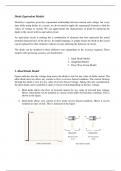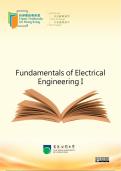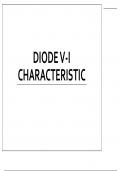Basic Electronics (ME223)
Arizona State University - West Campus
All 7 results
Sort by
This document are for anybody who is trying to understand the basic connection of light

-
Voltage Regulator - Zener
- Class notes • 17 pages • 2024
-
Available in package deal
-
zenniababayon
-
- $8.49
- + learn more
Zener diode is a voltage regulator device because it is able to fix the output voltage at a constant value (DC voltage). RS is to limit the zener current, IZ so that it is less than the maximum current, IZM (to avoid the zener diode from broken).

-
Rectifiers
- Class notes • 19 pages • 2024
-
Available in package deal
-
zenniababayon
-
- $8.49
- + learn more
A diode is used to pass current in a single direction. Alternating current is a current which flows in both directions. In some applications we need dc (direct current) power supply. A method to obtain dc supply is by using batteries. But it is not economical at all times. It is possible to obtain dc from ac supply .That process is known as rectification. Rectification is of two types: 1. Half wave rectification 2. Full wave rectification
Definition of Diode Current and Voltage • Forward Bias •When ID > 0mA and VD > 0V • Reverse Bias •When ID < 0mA and VD < 0V
Definition of Diode Current and Voltage • Forward Bias •When ID > 0mA and VD > 0V • Reverse Bias •When ID < 0mA and VD < 0V
Definition of Diode Current and Voltage • Forward Bias •When ID > 0mA and VD > 0V • Reverse Bias •When ID < 0mA and VD < 0V

-
Basic Electronics (Voltage Regulators - Zener, Rectifiers, Diode and Diode Equivalent models)
- Class notes • 3 pages • 2024
-
zenniababayon
-
- $9.89
- + learn more
An equivalent circuit is nothing but a combination of elements that best represents the actual terminal characteristics of the device. In simple language, it simply means the diode in the circuit can be replaced by other elements without severely affecting the behavior of circuit. The diode can be modeled in three different ways depending on the accuracy required.

Do you wonder why so many students wear nice clothes, have money to spare and enjoy tons of free time? Well, they sell on Stuvia! Imagine your study notes being downloaded a dozen times for $15 each. Every. Single. Day. Discover all about earning on Stuvia






